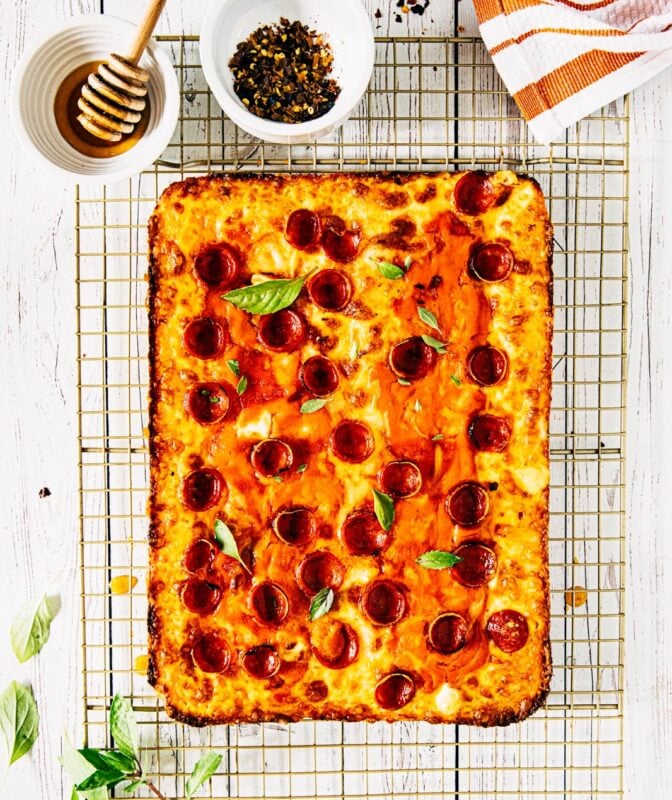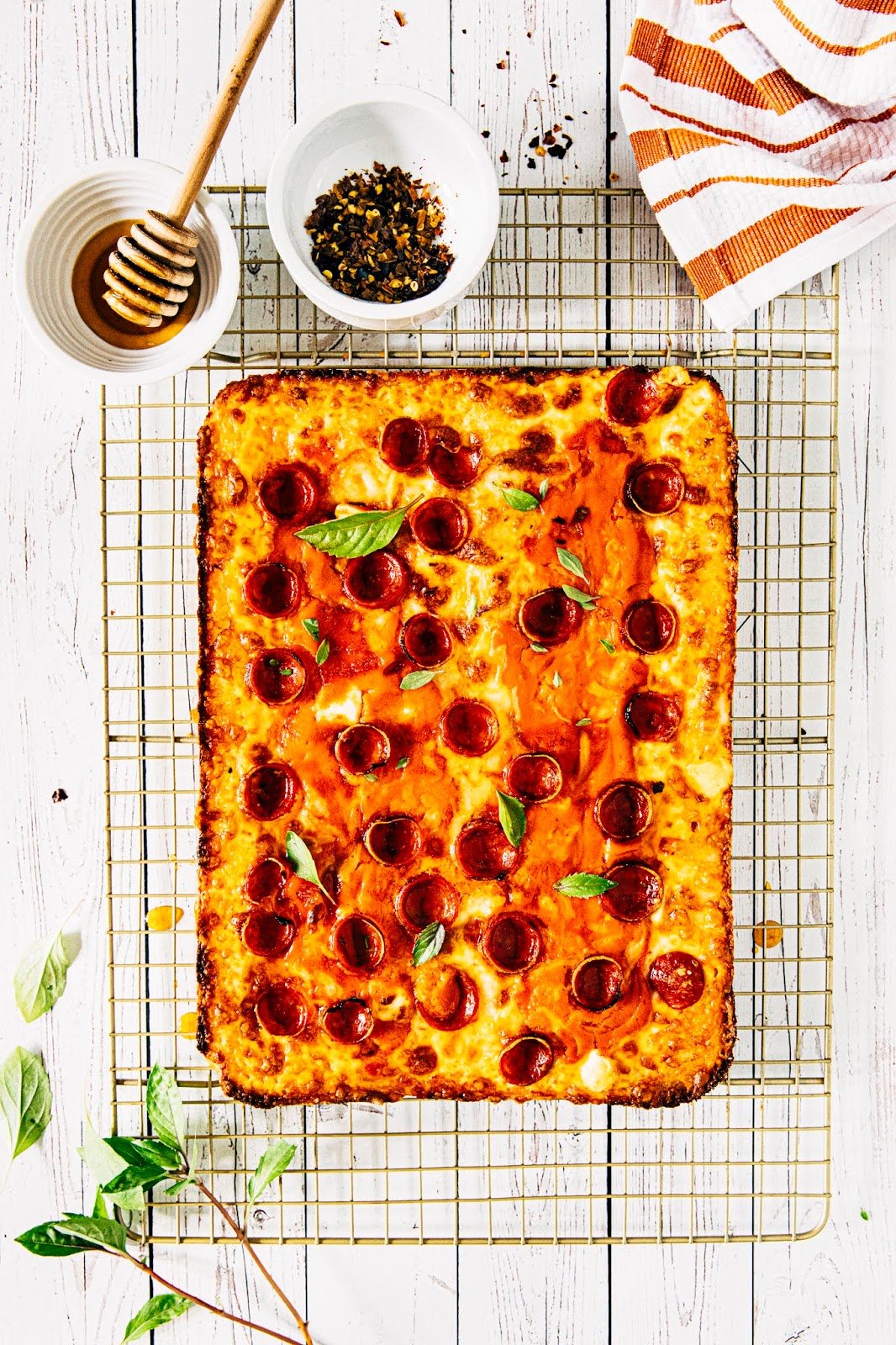Detroit style pizza is distinct for its rectangular shape and a thick crust made crispy with lots of melted cheese. Although the style of pizza first originated from Buddy’s Pizza in Detroit, this particular recipe is adapted from my favorite Detroit style pizzeria, Emmy Squared—jump to the recipe.
What is Detroit Style Pizza
Happy National Pepperoni Pizza Day! Yes, apparently that’s a real thing, and also apparently why I decided to share with you this recipe for Detroit style pizza today (even though you can apparently get $1 pizza deals from all the major chains, lol). It’s funny—although Detroit style pizza originated from Detroit (duh), I actually had my Detroit style slice in New York City (of all places!). At the time, I was living a neighborhood away from Emmy Squared, a restaurant in Brooklyn that was getting a ton of buzz for its pies.
You have to understand: pizza places in New York City are a dime a dozen, and most New Yorkers tend to be territorial and lazy when it comes to pizza. Sure, you’d occasionally get the folks willing to take the trip out to Midwood to pay homage to the classic Di Fara Pizza, and occasionally you could convince a group of friends to brave the lines for a hip night out at Roberta’s in Bushwick or Motorino in the East Village.
But most of the time, everybody was lazy—almost every neighborhood had its own pizza spot, and we tended to stick to them. Depending on where you lived too, your neighborhood could have multiple options to choose from—like there would be the nice one with the wine that you went to when you wanted a date night out, and then the one that sells the $1 slices that were only good between the hours of 1AM and 3AM, if you know what I mean.
So the fact that this particular spot was attracting a ton of buzz was a Very Big Deal. Furthermore, word on the street was that their pies was NOT the typical New York style—that is, HUGE with a very thin and chewy crust—that New Yorkers are very, VERY gung-ho about. In fact, Emmy Squared pizzas looked like the exact opposite of that: small and rectangular as opposed to large and circular, with a thick, heavy-looking crust that looked like the polar opposite of the prized New York thin crust.
Emmy Squared
With my curiosity piqued, I wrangled my friend Erin and her husband, Rich, to try Emmy Squared with me. Our waitress sat us down in a cramped, dark corner and explained that Emmy Squared pizzas were Detroit-style. Had we ever had that before? None of us had, and her face lit up. “You’re going to love it!” she then went on to describe how she liked to think of the style as a cross between that of a pizza and a grilled cheese sandwich. Although this meal happened literally years ago, I still remember the joy on her face as she described it—clearly, it stuck with me. “You know how when you get a really good grilled cheese, the edges are super crisp and almost burnt? You know, that cheese frico? That’s what the edges of this pizza are like!”
Detroit Style Pizza Recipe
Because of Detroit style pizza’s rectangular shape, folks often get Detroit style pizza confused with Sicilian style or Grandma style pizzas. All three are square (er, rectangular?) shaped pizzas, and are delicious.
But Detroit style pizza is definitely its own thing; some “pizza experts” argue that Detroit style pizza is made with a higher hydration dough. At first, I bought this completely—Sicilian and Grandma pie crusts tend to be lighter, more bubbly, and “spongier” than the crispy and close-textured Detroit style crust I know and love. But then I read elsewhere that Buddy’s Pizza (the folks often credited with creating the Detroit style in the first place) used a Sicilian pie dough recipe for their pizzas! Huh. Maybe the different texture is attributed to the way the dough is baked? While Sicilian and Grandma pizza are baked in regular sheet pans, Detroit pizza is baked in a “Detroit style pizza pan”. These pans are based on the industrial steel blue pan used by auto workers at Detroit’s factories of yesteryear to store small tools and parts; some enterprising Joe realized that the pans were the perfect size and material for making crispy crusted pizzas.
The only thing that folks seemed to be able to agree upon was the way that Detroit style pizza is assembled. Traditional pizzas are made first by spreading tomato sauce on the dough, and then topping the sauce with cheese and toppings. But with Detroit style pizzas, cheese goes on first—this is to allow the cheese to sink to the bottom and sides of the crust, creating the crispy frico edges. Sauce is then spooned over the cheese in two major strips across the pizza, and toppings are added last.
In any case, I was excited to finally unpack the secrets of my favorite Detroit style pizzeria with the help of Emmy Squared’s cookbook, EMILY: The Cookbook. I’d made Detroit style pizza before (using this Serious Eats recipe by Kenji), and was pretty satisfied with the results (I’ll post about them one day, I promise). And while I think that the results from their recipes was ultimately pretty tasty, I was definitely led astray by some of their advice in the book and definitely had to meld it in with some learnings from my trials with Kenji’s recipe. Be sure not to miss the baker’s notes below!
Best Detroit Style Pizza Recipe Tips
-
- Okay, guys—this is definitely a project. For the best homemade Detroit style pizza, you’ll need to invest in specific equipment: a baking steel OR a pizza stone, and Detroit style pizza pans. Baking steels and pizza stones help your oven maintain a high temperature by holding a lot of heat in them. Furthermore, you can get the bottom of whatever you’re baking SUPER crispy by placing the pan directly on the steel itself—some recipes even instruct you to bake the traditional pizzas directly on their surfaces! But if you’re not planning on making pizza that often, I actually suggest skipping it and taking a leaf from Kenji’s book—instead of setting the pizza pan on the steel/stone, simply set the pan on the bottom of the oven floor if possible.Now, Detroit style pizza pans are where it gets tricky. They’re available on Amazon, but for a price—I really didn’t want to pay that much money for one pan. And according to EMILY: The Cookbook, Detroit style pizza pans measure 7 x 11-inches (which directly contradicts this Eater article, which states that Detroit style pizza pans are either 8 x 10 or 10 x14 inches) and a good substitute can be found in the supermarket aisle where they sell temporary roasting pans made out of flimsy aluminum foil. Well, I checked my supermarket and most of the pans measure the standard rectangular size of 8 x 10-inches. The closest I found were this set of 8 ½ x 11 ½-inch at my local Safeway. I gave them a go, and honestly? They did not result in a crispy bottom crust, even after I upped the temperature of the original recipe and cooked it for MUCH longer than I needed to. In the end, I ended up taking the pizzas out of the pan and baking them directly on the stone for an extra few minutes to crisp it up. Eek.
If I were to make this recipe again, I wouldn’t bother sourcing the temporary pans and instead just use one of my commercial quarter sheet pans or follow Kenji’s suggestion of using two of these 8-inch black rectangular cake pans (which I did the first time). When making this pizza, always opt for darker colored pans—the dark color helps absorb and retain more heat, leading to a crispier pan.
- Okay, guys—this is definitely a project. For the best homemade Detroit style pizza, you’ll need to invest in specific equipment: a baking steel OR a pizza stone, and Detroit style pizza pans. Baking steels and pizza stones help your oven maintain a high temperature by holding a lot of heat in them. Furthermore, you can get the bottom of whatever you’re baking SUPER crispy by placing the pan directly on the steel itself—some recipes even instruct you to bake the traditional pizzas directly on their surfaces! But if you’re not planning on making pizza that often, I actually suggest skipping it and taking a leaf from Kenji’s book—instead of setting the pizza pan on the steel/stone, simply set the pan on the bottom of the oven floor if possible.Now, Detroit style pizza pans are where it gets tricky. They’re available on Amazon, but for a price—I really didn’t want to pay that much money for one pan. And according to EMILY: The Cookbook, Detroit style pizza pans measure 7 x 11-inches (which directly contradicts this Eater article, which states that Detroit style pizza pans are either 8 x 10 or 10 x14 inches) and a good substitute can be found in the supermarket aisle where they sell temporary roasting pans made out of flimsy aluminum foil. Well, I checked my supermarket and most of the pans measure the standard rectangular size of 8 x 10-inches. The closest I found were this set of 8 ½ x 11 ½-inch at my local Safeway. I gave them a go, and honestly? They did not result in a crispy bottom crust, even after I upped the temperature of the original recipe and cooked it for MUCH longer than I needed to. In the end, I ended up taking the pizzas out of the pan and baking them directly on the stone for an extra few minutes to crisp it up. Eek.
-
- This particular pizza is based on my favorite Emmy Squared pizza, the Colony Squared, which was topped with pepperoni, pickled hot peppers, and honey (honey on pizza is amazing—don’t knock it until you’ve tried it!). I was too lazy to pickle the peppers, so I ended up using hot honey, which is honey infused with chiles—the most popular brand is Mike’s Hot Honey, but there’s also this Bee Local Hot Honey from Portland (represent!). Be sure to use pepperoni that’s on the smaller side, and slice it as thinly as you can; this will cause the pepperoni slices to curl up when baked, becoming perfect little cups to hold the hot honey!
- Finally, the secret for success with this recipe lies in your timing. The dough will need to be chilled and rise twice—the first rise happens while you’re chilling the dough overnight in the fridge, and the second rise happens at room temperature. You’ll then need to put the dough back into the fridge after this rise (Because apparently, according to EMILY: The Cookbook, if you attempt to assemble and bake the pizza at this point without chilling it, it will collapse into itself—yikes! Kenji’s recipe was not this fussy). Here’s how I ended up making this work for my schedule: think of it as a weekend project, a dinner for a Saturday or Sunday night. The night before you plan on baking the pizzas, make the sauce and dough. Chill the dough overnight in the fridge. The next day, first thing in the morning, fit the dough into their pans. Let rise at room temperature for an hour and a half while you do your thing, then stick them in the fridge to chill. Later that day, assemble and bake the pizzas accordingly. Whew. It’s a lot, I know, but you got this!
Get the Recipe: Emmy Squared Detroit Style Pizza Recipe
Ingredients
For the Red Sauce
- 1 ½ tablespoons olive oil
- ⅓ cup around 1 ounce finely chopped yellow onion
- 3 garlic cloves, roughly chopped
- ¼ cup 2 ounces dry white wine
- 1 15-ounce can crushed tomatoes
- 1 ½ teaspoons kosher salt
- ½ teaspoon dried oregano
For the Detroit Pizza Dough
- ¼ cup 2 ounces warm water, between 105°F to 115°F
- 1 teaspoon granulated sugar
- 1 teaspoon instant yeast
- 1 ¼ cup 10 ounces cold water
- 4 cups plus 1 tablespoon (18.70 ounces) bread flour
- 2 ¼ teaspoons kosher salt
- 1 ½ tablespoons canola oil
- For the Colony Squared Pizzas
- 1 cup shredded mild cheddar
- 1 cup shredded low-moisture mozzarella
- 1 ½ cups Red Sauce, recipe above
- 6 tablespoons freshly grated pecorino romano
- 1 cup thin pepperoni slices, see baker's notes
- 3 tablespoons hot honey, see baker's notes
- fresh basil
Equipment
- Special Equipment: a high-powered blender
- a baking steel or a pizza stone (see baker’s notes)
- 3 Detroit style pizza pans (see baker’s notes)
Instructions
For the Red Sauce
- Heat the olive oil in a medium saucepan over medium heat. Add the onion and cook, stirring occasionally, until the onion is translucent but not browned, about 3 minutes. Stir in the garlic and pour in the wine. Increase the heat to high and boil until the wine is reduced by half, 3 to 5 minutes.
- Pour the mixture into a blender and add the tomatoes, salt, and oregano. Pulse just to combine. Store the sauce in an airtight container in the refrigerator for up to 3 days, or in the freezer for up to 2 months.
For the Detroit Pizza Dough
- Start the dough 24 to 48 hours before making the pizzas. Use a rubber spatula to mix the warm water, sugar, and yeast in the bowl of a stand mixer fitted with a dough hook and let stand for 5 minutes. After 5 minutes, the mixture should look frothy. Add the cold water and mix to combine.
- Sprinkle the flour and salt over the mixture. Turn the mixer on to medium and mix just until the dough comes together. Leave the hook in place and drape a kitchen towel around the open top of the bowl to cover it. Let the dough stand for 10 minutes.
- After 10 minutes, remove the towel and turn the mixer back on to medium-low speed. Knead the dough, occasionally using the spatula to pull down the dough if it climbs up the hook, until the dough is smooth and elastic, 6 to 8 minutes. At this point, the dough will be soft, sticky, and easily pull away from the sides of the bowl. Increase the mixer to medium-high and drizzle in the oil, kneading until absorbed, about 2 minutes.
- Use the spatula to scrape out the dough onto a lightly floured counter. Spray the inside of the mixer bowl with a light coating of cooking spray. Place the dough back in the bowl and cover the top of the bowl with plastic wrap. Refrigerate for at least 8 hours, preferably overnight, but no longer than 48 hours.
Proofing the Pizza Dough
- Once the dough is chilled, use a rubber spatula to scrape the dough onto lightly floured counter. Place the mixer bowl on a digital scale and tare the scale so it reads "0"; place the dough back in the bowl to weigh it. The dough should weigh around 31.75 ounces. Use a bench scraper to divide the dough into three smaller portions, each weighing around 10.50 ounces.
- Prepare three Detroit style pizza pans by generously spraying with cooking spray. Place a dough portion in the center of each pan. Pat each dough portion to stretch and spread it across the surface of its pan. You’ll need to flour your hands occasionally to prevent the dough from sticking. At first, it will seem like each pan does not have enough dough for it to reach the edges—spread it as much as you can without tearing, then move on to the next pan, and the one after that. Return to dough and stretch it out again. It should be able to reach the edges this time. If not, let it rest a little more, switching from pan to pan, and trying again.
- Cover each pan with plastic wrap and secure it in place with rubber bands at the opposite ends. Let the dough rise at room temperature until the dough looks slightly puffy but not doubled, about 1 ½ hours. After that, transfer the pans with the dough to the refrigerator to chill for at least 2 hours or up to 36 hours before assembling into Detroit pizza.
Assembling and Baking the Pizzas
- At least 2 hours before baking the pizzas, place a baking steel or a pizza stone in the bottom third of the oven and preheat the oven to 550℉. If your oven has a convection fan option, now's the time to use it!
- Remove one pizza pan from the refrigerator (keep the others in the fridge!) and discard the plastic wrap. Mix ⅓ cup cheddar and ⅓ cup mozzarella in a small bowl. Sprinkle about two-thirds of the cheese heavily around the edges of the pan and evenly scatter the remainder in the central section of the dough. Using ½ cup of Red Sauce, spoon two strips onto the pizza—each strip should be around 1 ½ inches wide, with about 1 inch between them. Sprinkle with 2 tablespoons pecorino romano and scatter with ⅓ cup pepperoni slices (it will seem like a lot of pepperoni, but the pepperoni will shrink and shrivel in the oven).
- Place the pan onto the steel or stone in the oven and bake for about 10 minutes, or until the top of the pie is golden brown with crisp edges. Remove the pan from the oven and let stand on a wire rack for 1 minute. Using a small sharp knife, loosen the pizza around all four sides and use a stiff metal spatula to transfer it to a wire rack. Check the bottom of the pizza crust—the crust should be browned—they won't be as brown as the pizza edges, but it'll need to look like a good toasting. If the crust looks pale, transfer the pizza back to the oven, this time directly sliding it onto the pizza stone. Bake for another 2 to 3 minutes. If not, proceed to the next step.
- Immediately drizzle with 1 tablespoon hot honey and scatter with fresh basil leaves. Serve immediately. Repeat with the remaining pizza doughs when ready for more. ????







